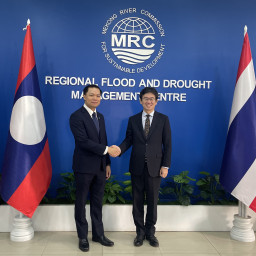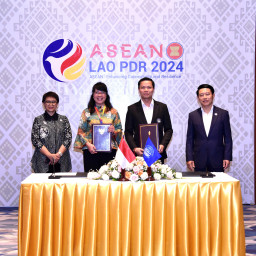MRC launches first 24-hour navigational aid system in Cambodia

The first buoy hits the water. Solar panels will provide 24 hour power. Photo:MRC/Garrison Photography
The Mekong River Commission today laid the inaugural navigational buoy in Chaktomuk area in the access channel to Phnom Penh Port as the start of what will be the first 24-hour navigational aid system on the Mekong in Cambodia.
The navigational aids project is part of the MRC’s Navigation Programme which is funded by the Government of Belgium.
The buoy was released in an onboard ceremony by H.E. Mr. Sun Chanthol, Minister of Public Works and Transport, H.E Mr Tram Iv Tek, Secretary of State of the Ministry of Public Works and Transport, Vice Chairman of the Cambodia National Mekong Committee, H.E. Mr Jan Matthysen, Ambassador of Belgium to Thailand and Dr Olivier Cogels, Chief Executive Officer of the Mekong River Commission Secretariat.
The launch of this buoy also marks Mekong Day, the day which celebrates the anniversary of the forming of the Mekong River Commission on 5th April 1995 – this year is the 12th anniversary.
Over the next six months, the Aids to Navigation on the Mekong River Project, will install 56 buoys of three types and 12 leading markers over a 100km stretch of the Mekong River, the busiest stretch of the Mekong in Cambodia. These buoys will mark a safe channel from Phnom Penh Port to the Cambodia-Viet Nam border. The installation of this internationally recognised system of aids to navigation such as buoys, beacons and shore marks, aims to improve safety and efficiency of navigation so that sea-going vessels and inland barges can safely navigate for 24 hours a day in safety.
H.E. Mr. Sun Chanthol said that a system such as this would be of enormous assistance to Cambodia in increasing its export potential, as the river would become a reliable and more economic form of transport. “The quality of waterborne transport will be improved, waiting times will be shortened, night navigation will be possible, and river transportation will be more cost-effective and efficient,” he said.
A cost benefit study has shown that up to US$45 million can be saved per year in transport costs is the Mekong River can be used to transport containers between Phnom Penh and Ho Chi Minh City, but also directly to ports such as Singapore and Hong Kong.”
The promotion of the river for economic development was important but so was safety on the river, said H.E. Mr Tram Iv Tek. “A lack of aids to navigation is the main cause for various accidents from collisions, ships running aground, and risks for pollution, threatening the ecosystem of the river. Prevention of accidents is a high priority for the MRC and the Cambodia National Mekong Committee for the simple reason that many of the people of the basin, particularly in Cambodia depend largely on the resources of the Mekong for their daily living. A pollution accident could be a serious threat to the livelihoods of these people. Properly marking the channel will reduce these risks significantly.”
Dr Olivier Cogels stressed the importance of the transboundary nature of this project in the context of the whole of the MRC’s Navigation Programme.
“Article 9 (Freedom of Navigation) of the Agreement on the Cooperation for the Sustainable Development of the Mekong River Basin, which was signed 12 years ago today and formed the Mekong River Commission, states that: “The Mekong River shall be kept free from obstructions, measures, conduct and actions that might directly or indirectly impair navigability interfere with this right or permanently make it more difficult,” he said.
“This initial installation project is part of our bigger plans to open up the Mekong and reduce physical and non-physical barriers to free navigation. As part of its mandate, the Navigation Programme is in the process of facilitating a Navigation Agreement between Cambodia and Viet Nam and establishing a legal framework between those two countries Nam which will facilitate passage of vessels and cargo, and boost confidence among investors.
“This new navigational aids system will also form a basis for new commitments and closer cooperation between Cambodia and Viet Nam as well as opening up more trade opportunities between the two countries.”
The Mekong River Commission, through the Navigation Programme is the Executing Agency of the Installation of Aids to Navigation Project. The 12-month project started in November 2006 and is being implemented by Australian Maritime Systems Ltd in cooperation with Phnom Penh Autonomous Port and the Waterways Department of the Ministry of Public Works and Transport. The equipment is manufactured by Mobilis Co. Ltd. (France) and distributed by Tempest Co. Ltd. (Belgium).
-ends-
For More Information
Mr. Damian Kean, Interim Communication AdvisorTel: +856 56120695 or +856 21 263 263 Ext. 4703
Email: damian@mrcmekong.org




